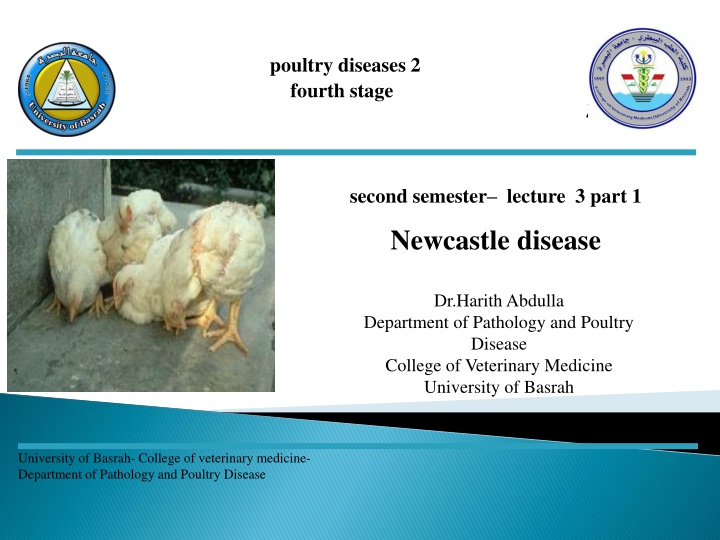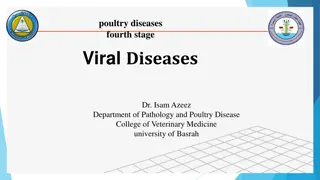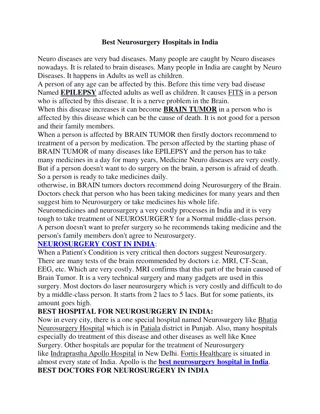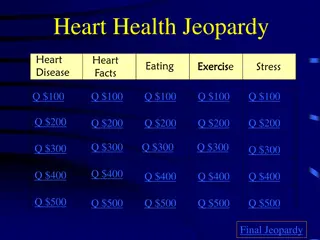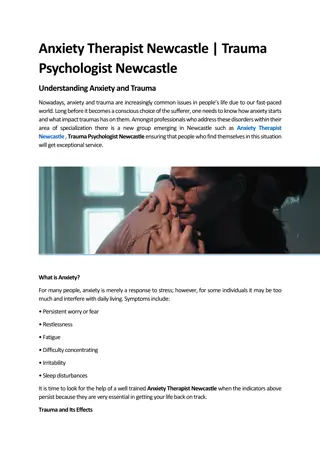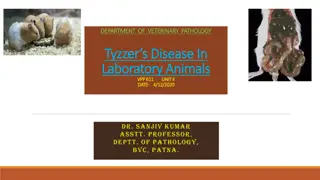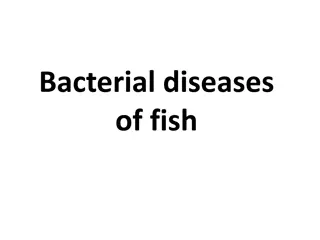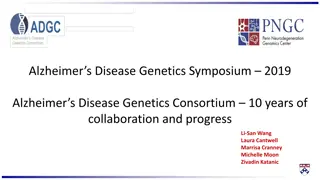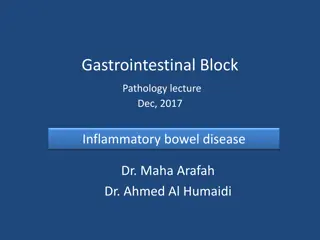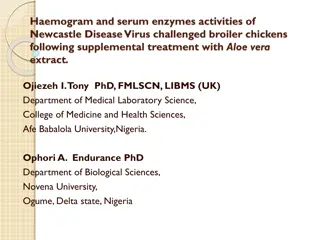Newcastle disease
Newcastle disease is a highly contagious viral infection affecting domestic and wild birds. This disease, caused by Paramyxovirus type 1, poses a significant threat to poultry health and productivity. The disease manifests in various forms such as Velogenic Newcastle Disease, Beach's form, Beaudette's form, Hitchner's form, and Asymptomatic enteric form. Different strains of Newcastle disease virus, including Lentogenic, Mesogenic, and Velogenic, exhibit varying virulence levels. Understanding the spread, clinical signs, and mortality rates associated with Newcastle disease is crucial for effective management in poultry populations.
Download Presentation

Please find below an Image/Link to download the presentation.
The content on the website is provided AS IS for your information and personal use only. It may not be sold, licensed, or shared on other websites without obtaining consent from the author.If you encounter any issues during the download, it is possible that the publisher has removed the file from their server.
You are allowed to download the files provided on this website for personal or commercial use, subject to the condition that they are used lawfully. All files are the property of their respective owners.
The content on the website is provided AS IS for your information and personal use only. It may not be sold, licensed, or shared on other websites without obtaining consent from the author.
E N D
Presentation Transcript
poultry diseases 2 fourth stage second semester lecture 3 part 1 Newcastle disease Dr.HarithAbdulla Department of Pathology and Poultry Disease College of Veterinary Medicine University of Basrah University of Basrah- College of veterinary medicine- Department of Pathology and Poultry Disease
Newcastle disease O Highly contagious and fatal viral disease of most domestic fowl as well as many wild and pet bird. O Newcastle disease virus may cause conjunctivitis in humans. OEtiology: Paramyxovirus type 1 ,single stranded RNA virus.
Forms of Newcastle disease 1-Doyle Doyle s form Velogenic Newcastle Disease ( VVND ), Digestive form , Exotic form : Acute lethal infection of all ages of chickens. Hemorrhagic lesions of digestive tract are present. s form Asciatic form , Viscerotropic : 2- Beach Beach s form chickens of all ages ,characterized by respiratory and neurological signs , hence the term ,Neurotropic Velogenic Newcastle Disease (NVND ) ,and pneumotropic velogenic ND . s form : An acute ,often lethal infection of
Forms of Newcastle disease 3-Beaudette Beaudette s form deaths are seen only in young birds..Viruses causes this type of infection are of mesogenic pathotype. s form : Less pathogenic form of NVND , 4- Hitchner Hitchner s form respiratory infections, caused by the viruses of the lentogenic pathotype. 5- Asymptomatic Asymptomatic enteric form: enteric form: Gut infections with lentogenic viruses causing no obvious disease. s form : Causes mild or inapparent
Strains of ND viruses 1. Lentogenic ND virus : Mild : Kills embryos in more than 90 hours. 2. Mesogenic ND virus : Moderate : Kills embryos in 60 -90 hours. 3. Velogenic : Highly virulent neurotropic or viscerotropic : Kills embryo in less than 60 hours. Lentogenic Lentogenic and Mesogenic strains are used as vaccines. and Mesogenic strains are used as vaccines.
Method of spread 1. Aerosol from infected bird excretions. 2. Mechanical vectors. 3. Vaccinations : May cause the disease. 4. Wild birds. OMortality: 1. Lentogenic and mesogenic :Negligible if not complicated. 2. Velogenic: Up to 50 % in adults and 90 % in chicks. 3. Exotic ND ( VVND ) :Up to 90 -100 % .
Clinical signs : Young 1.Respiratory signs: discharge. 2.CNS signs : Follow respiratory signs : Twisted neck , stargazing and opisthotonus. Gasping, coughing ,rales and nasal 3.Signs of digestive system : Diarrhea , greenish diarrhea , bloody diarrhea. 4.Ocular signs: Lacrimation and conjunctivitis.
Clinical signs : Adult 1- Mild respiratory signs. 2- Few CNS signs. 3- Layers may cease to produce . 4- Eggs are of low quality and rough or soft shell .
Post mortem lesion 1-Severe inflammation of trachea and air sacs. 2-Hemorrhagic ulcerations in the mucosa of gut and cecal tonsils. 3- Severe hemorrhages of mucosal surface of the proventriculus and gizzard.
Differential diagnosis 1. Infectious Bronchitis. 2. Colibacillosis (Airsacculitis). 3. Bird flu (Avian Influenza). 4. Marek s Disease (Nervous form). 5. Infectious Laryngotracheitis. 6. Avian Encephalomyelitis. 7. Infectious Coryza. 8. Chronic Respiratory Disease ( CRD ) 9. Aspergillosis. 10. Vitamin E Deficiency .
Diagnosis 1. History . 2. HI ( Hemagglutination Inhibition Test ) . 3. VN ( Virus Neutralization) with known ND antisera. 4. ELISA. 5. Immunofluorescence . 6. Signs. 7. Gross lesions. 8. Isolation and identification of virus. 9. Reproduction of the disease in susceptible chickens.
Treatment No treatment. Broad spectrum antibiotics for secondary bacterial infection. Prevention : 1-Vaccination 2- Eradication.
